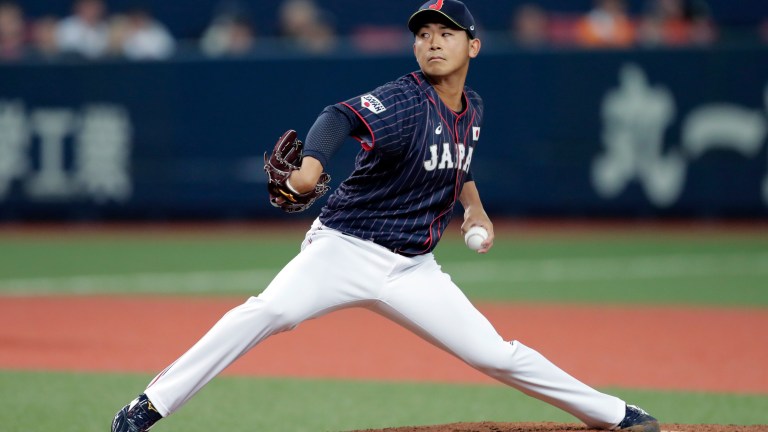Japanese Left-Hander Shota Imanaga Will Have Plenty of MLB Suitors
Taking a back seat to the allure of fellow NPB product Yoshinobu Yamamoto, Imanaga's track record and unique pitch characteristics should still command a lucrative multi-year deal.

In most free agency cycles, Japanese left-hander Shota Imanaga would be the top international free agent target for teams, especially coming off of a year where he led Nippon Professional Baseball (NPB) in strikeouts with 174 while posting a 2.66 ERA.
A two-time NPB All-Star, Imanaga tossed a no-hitter in 2022, owns a career ERA of 2.96 and has pitched for Japan in both the 2019 Olympics and 2023 World Baseball Classic, where he started the championship game against Team USA.
While young stars like right-hander Yoshinobu Yamamoto and centerfielder Jung Hoo Lee may have Imanaga overshadowed a bit in terms of airtime, there will likely be no shortage of interest in the 30-year-old southpaw and his intriguing arsenal.
Four-Seam Fastball (90-93 MPH)
Much like Yamamoto, Imanaga uses his 5-foot-10 frame to his advantage, weaponizing a high carry fastball from a 5.5 foot release height. As detailed in the Yamamoto breakdown, the average four seam release height is around 5.9 feet in MLB, with about 80% of pitchers letting their heater fly from a higher slot than the two Japanese stars.
While his average fastball velocity is about two ticks below the MLB average of 94 MPH, Imanaga’s outlier shape of his fastball helps it play like a plus pitch. The average induced vertical break for a big league fastball at a 5.5-5.6 foot release is roughly 16 inches — Imanaga averages more than 19 inches at more than 2,500 RPM.
As you can see in the video below, Imanaga controls his body exceptionally well, holding his elongated leg kick well while dropping deep into his back leg to create power and drive from a lower center of gravity.
Not only does he create deception and carry to help his fastball flutter over barrels, but Imanaga also has superb command of the pitch. He landed the pitch for a strike 74% of the time in 2023, with a swinging strike rate of 12%.
With a usage rate above 50%, in-zone rate above 60% and a willingness to attack the top of the zone for whiffs, Imanaga can be a bit susceptible to the long ball, allowing 16 homers on his fastball in 159 IP in 2023. However, the vast majority were solo shots.
The home runs are palatable when opponents are hitting in the low .200s against the pitch and free passes are hard to come by. Since the start of the 2021 season, Imanaga has yielded a batting average around .220 with an OPS in the mid .600s against his fastball.
There really isn’t a direct comparison fastball wise with Imanaga, as no pitcher gets more than 19 inches of vertical break from a 5.5 foot release, but the fastballs in the table below share some commonalities.
While Imanaga’s velocity is several ticks below several of the pitchers he is being compared to, his release height is lower than Cortes, Vesia and Javier with a smidge more extension. Regardless, each of these fastballs were some of the most effective in baseball.
| Shota Imanaga (2023) | VELO: 91.5 | RH: 5.5 | IVB: 19 in. | EXT: 6.2 | SwStr: 11.4% |
| Nestor Cortes (2022) | VELO: 91.6 | RH: 5.8 | IVB: 19.8 in. | EXT: 5.8 | SwStr: 12.8% |
| Alex Vesia (2023) | VELO: 94.4 | RH: 5.7 | IVB: 19.7 in. | EXT: 5.8 | SwStr: 15.9% |
| Cristian Javier (2022) | VELO: 93.8 | RH: 5.65 | IVB: 19 in. | EXT: 6.0 | SwStr: 15% |
| MLB Average | Velo: 94.2 | RH: 5.9 | IVB: 15.7 in. | EXT: 6.5 | SWSTR: 10.7% |
The most similar fastball to Imanaga’s is that of Cortes, also sitting a half tick below 92 MPH, but misses plenty of barrels by averaging more than 19 inches of induced vertical break. While there’s no doubting the value of a fastball sitting in the mid 90s rather than the low 90s, shape can be equally, if not more, important.
According to Driveline, four seam fastballs at 91 MPH with between 18-20 inches of induced vertical break will pick up the same amount of whiff as a four seamer at 97 MPH with 12-14 inches of induced vertical break. Just as pitchers can touch higher velocities, they can also throw fastballs that flash more elite characteristics. Despite averaging around 19 inches of IVB, Imanaga will mix in plenty of fastballs with 20+ inches of IVB.
It’s also important to note that this fantastic chart below by Driveline’s Director of Pitching Chris Langin does not include release height, which also has significant impact on the effectiveness of a heater. In fact, the data would argue that Imanaga’s 0.3 feet lower release height and 0.4 feet of additional extension over Cortes is more conducive to whiffs than the 0.8 inches of IVB the Yankees southpaw has over him.

Splitter/Changeup (83-85 MPH)
Like many of the top NPB arms, Imanaga’s splitter is clearly his most dominant secondary pitch. He will throw two variations of the split grip, as well as a more traditional changeup. He goes to one of the three around 17% of the time and mostly to right-handed hitters. The pitch works off of his fastball well, duplicating his arm speed and release point well before the bottom drops out of the ball.
The more traditional variation of the split is easily his most dominant secondary, filling up the zone at a 67% clip while picking up a chase rate just shy of 50% and swinging strike rate of 23%. He kills spin impressively, averaging hardly above 1,000 RPM with late drop.
Imanaga’s changeup is a bit less consistent from a command standpoint, though it features a bit more horizontal movement and is more than a tick harder. Against both the splitter and changeup last season, righties hit just .220 with a 37% strikeout rate.
With one of the questions around Imanaga being his ability to keep the ball in the yard, it will be interesting to see if he will use his splitter more than his changeup, as the former picked up a ground ball rate of 55% in 2023, more than 10% above his changeup. Regardless, the options should be an advantage for him as he acclimates to the feel of an MLB ball.
Slider (79-82 MPH)
Imanaga’s go-to weapon against left-handed hitters is his slider, utilizing it 25% of the time against same-handed hitters and 15% of the time overall after previously favoring a cutter. He throws two variations of the pitch: one version features more sweep in the upper 70s, while the other is a more traditional slider in the low 80s.
In his shorter outings during the World Baseball Classic, Imanaga’s more sweepy version of his slider flashed plus, picking up as much as 17 inches of horizontal break while flirting with the mid 80s. It will likely play as an above average pitch in the big leagues with a starter’s workload.
NPB opponents hit around .250 against the pitch in 2023 and really struggled to produce much impact. Imanaga yielded a slugging percentage against it of just .350; that figure dropped to .290 left-on-left. His command of the pitch is not quite as fine as his splitter, though a 61% strike rate with the offering is right around average.
Cutter (85-87 MPH)
A pitch used far more frequently in previous seasons, Imanaga cut his cutter usage in half to roughly 7%. He commands the cutter well to his glove side, wearing out that side of the plate to either catch left-handed hitters off of the end of the bat or tie up right-handed hitters.
The whiff rates on the pitch have settled closer to average over the last couple seasons, but he has picked up a chase rate of almost 40% resulting in plenty of weak contact. Filling up the strike zone at a near 70% clip last season, Imanaga has plenty of confidence with his cutter and could lean on it some more stateside.
Curveball (71-75 MPH)
More of a taste-breaking offering than a swing and miss pitch, Imanaga will mix in his curveball around 7% of the time. It was his most inconsistent pitch in 2023 from a command standpoint with a strike rate of just 51% and is mostly used to catch hitters off guard and steal early strikes.
MLB Outlook
You don’t lead NPB in strikeouts by accident, and his 174 whiffs in 148 innings of work topped Yoshinobu Yamamoto for the league lead in 16 fewer innings. Of course, Yamamoto’s arsenal is as electrifying as they come, but Imanaga’s elite fastball characteristics and feel to pitch should help him miss plenty of big league bats as well.
With a fastball designed to cause hitters to swing under it and high overall usage, Imanaga’s susceptibility to the long ball will only become more of a point of emphasis for him against better competition.
Nestor Cortes serves as an excellent precedent when it comes to a low 90s fastball with around 50% usage succeeding. It’s arguable that Imanaga’s fastball has even more elite characteristics along with stronger secondaries, elevating his ceiling a bit higher than the Yankees southpaw.
With the majority of the league pursuing pitching help, the 30-year-old should have no shortage of teams willing to offer him a multi-year deal, and picking a pitcher’s park to call home could help ease his transition.
Imanaga’s 36% ground ball rate in 2023 would have tied Dylan Cease for 7th lowest among qualified starters with only 13 yielding a ground ball rate below 40% last season. Within that group of 13 are guys like: Gerrit Cole, Spencer Strider, Luis Castillo and Justin Verlander — all dominant arms who can get bit by the long ball at times.
With multiple variations of both of his secondary offerings, there could be a feeling out process for Imanaga as he gets used to which pitches are easiest for him to command with the less-tacky MLB baseball as well as simply seeing what gets more whiffs against MLB competition. The good news is it’s great to have options, and he can probably get away with 60% fastball usage in spurts. That said, his fastball and splitter have each looked like plus pitches through stretches, and the sweeper variation of his slider appears to be a well above average offering to get same-handed hitters out. Mix in a traditional slider along with a cutter, changeup, and curveball, and you get a unique arsenal capable of making Imanaga a strong middle-rotation option in the toughest league in the world.






